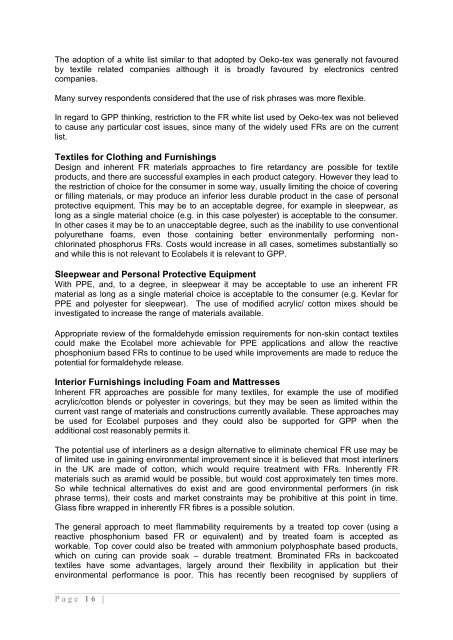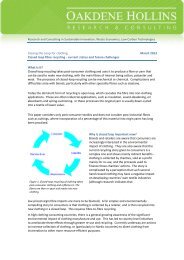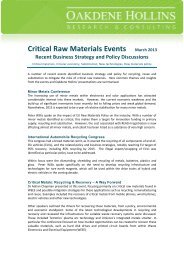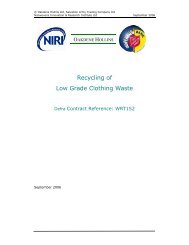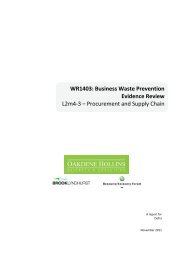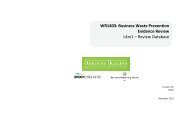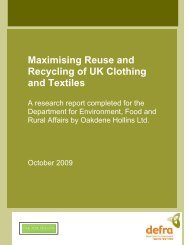Fire Retardant Technologies: safe products with ... - Oakdene Hollins
Fire Retardant Technologies: safe products with ... - Oakdene Hollins
Fire Retardant Technologies: safe products with ... - Oakdene Hollins
- No tags were found...
You also want an ePaper? Increase the reach of your titles
YUMPU automatically turns print PDFs into web optimized ePapers that Google loves.
The adoption of a white list similar to that adopted by Oeko-tex was generally not favouredby textile related companies although it is broadly favoured by electronics centredcompanies.Many survey respondents considered that the use of risk phrases was more flexible.In regard to GPP thinking, restriction to the FR white list used by Oeko-tex was not believedto cause any particular cost issues, since many of the widely used FRs are on the currentlist.Textiles for Clothing and FurnishingsDesign and inherent FR materials approaches to fire retardancy are possible for textile<strong>products</strong>, and there are successful examples in each product category. However they lead tothe restriction of choice for the consumer in some way, usually limiting the choice of coveringor filling materials, or may produce an inferior less durable product in the case of personalprotective equipment. This may be to an acceptable degree, for example in sleepwear, aslong as a single material choice (e.g. in this case polyester) is acceptable to the consumer.In other cases it may be to an unacceptable degree, such as the inability to use conventionalpolyurethane foams, even those containing better environmentally performing nonchlorinatedphosphorus FRs. Costs would increase in all cases, sometimes substantially soand while this is not relevant to Ecolabels it is relevant to GPP.Sleepwear and Personal Protective EquipmentWith PPE, and, to a degree, in sleepwear it may be acceptable to use an inherent FRmaterial as long as a single material choice is acceptable to the consumer (e.g. Kevlar forPPE and polyester for sleepwear). The use of modified acrylic/ cotton mixes should beinvestigated to increase the range of materials available.Appropriate review of the formaldehyde emission requirements for non-skin contact textilescould make the Ecolabel more achievable for PPE applications and allow the reactivephosphonium based FRs to continue to be used while improvements are made to reduce thepotential for formaldehyde release.Interior Furnishings including Foam and MattressesInherent FR approaches are possible for many textiles, for example the use of modifiedacrylic/cotton blends or polyester in coverings, but they may be seen as limited <strong>with</strong>in thecurrent vast range of materials and constructions currently available. These approaches maybe used for Ecolabel purposes and they could also be supported for GPP when theadditional cost reasonably permits it.The potential use of interliners as a design alternative to eliminate chemical FR use may beof limited use in gaining environmental improvement since it is believed that most interlinersin the UK are made of cotton, which would require treatment <strong>with</strong> FRs. Inherently FRmaterials such as aramid would be possible, but would cost approximately ten times more.So while technical alternatives do exist and are good environmental performers (in riskphrase terms), their costs and market constraints may be prohibitive at this point in time.Glass fibre wrapped in inherently FR fibres is a possible solution.The general approach to meet flammability requirements by a treated top cover (using areactive phosphonium based FR or equivalent) and by treated foam is accepted asworkable. Top cover could also be treated <strong>with</strong> ammonium polyphosphate based <strong>products</strong>,which on curing can provide soak – durable treatment. Brominated FRs in backcoatedtextiles have some advantages, largely around their flexibility in application but theirenvironmental performance is poor. This has recently been recognised by suppliers ofP a g e 16 |


